The ExceptionHandler Orchestration
The Business Process Management solution uses two kinds of exceptions: system exceptions and application exceptions. System exceptions include things like resource errors—a network connection failing, for example. There is a chance that such a problem may resolve itself after an interval so that the solution retries all operations that produce system exceptions. Application exceptions are produced by things less likely to resolve themselves, such as logical errors or some form of inconsistency. The solution uses the ExceptionHandlerOrch orchestration to process both system and application errors.
The order processing stages (CableOrder1, CableOrder2) and their satellite orchestrations (Activate, Analyze, Cancel, Change, Complete, Validate) all use ExceptionHandlerOrch.
Note
You may want to read this section with the ExceptionHandlerOrch orchestration open in Microsoft Visual Studio.
Application Errors
The exception handler first logs the error by calling the PostError method of the ErrorHandler object in the Utilities assembly. The exception handler then tests whether the error was a system error or an application error. The following screenshot shows the orchestration branch that processes application exceptions:
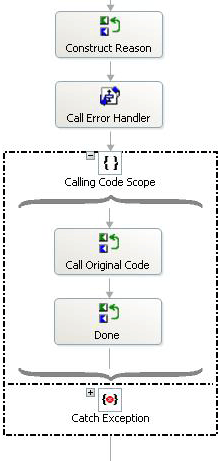
For an application error, the orchestration constructs a string describing the error and calls the ErrorHandlerOrch orchestration. This orchestration sends the error to operations where an operator decides whether to fix the error or terminate the operation. If the operator fixes the error, the repaired message comes back from the ErrorHandlerOrch orchestration and the operation is retried. The exception handler does this by calling the Invoke method of the Recaller object in the Utilities assembly. The Recaller object uses reflection to call the code that caused the error.
If the call to Invoke succeeds, the exception handler exits. Otherwise, it loops back and attempts the call to Invoke again. For more information about the Recaller object, see The Recaller Object.
System Errors
The following diagram shows the system error branch of the ExceptionHandler orchestration:
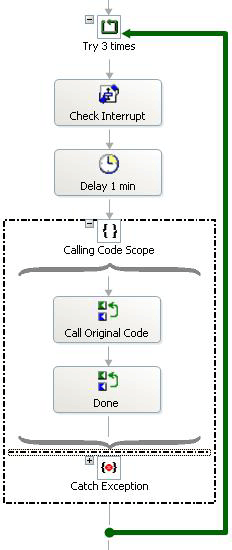
For a system error, the exception handler first calls the CheckInterrupt orchestration and then waits for one minute. The wait allows for temporary, short-term errors such as network connection problems, to clear before trying again. When making remote calls there is always the chance of a network problem.
Note
In an interruptible design, as a general rule, you want to test for an interrupt during or immediately after any waiting period to see if an interrupt has occurred.
After the wait, the handler uses the Invoke method of the Recaller object to run the original code. If the call succeeds, the handler exits. Otherwise, the handler will try two more times to run the original code. If all three attempts fail, the handler constructs an error string and calls the ErrorHandlerOrch orchestration.
If processing a system exception causes an exception, the exception block catches it:
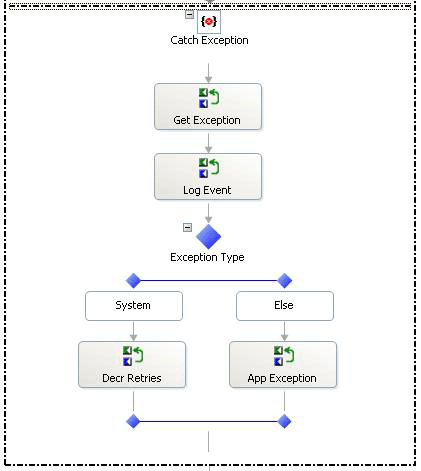
The exception handler tests the type of the exception and either decrements the retry counter if it's a system exception, or sets a flag to indicate an application exception.
The ErrorHandlerOrch Orchestration
The following diagram shows the first part of the ErrorHandlerOrch orchestration:
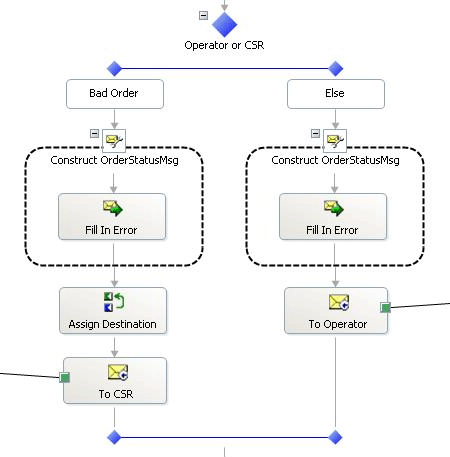
The ErrorHandlerOrch orchestration first tests the IsBadOrder parameter to see if the error is a bad order (IsBadOrder is true) or some other error. If the error is a bad order, it assigns the destination of the message from the original order return address and sends the message back to the customer service system. If the error is not a bad order, the orchestration creates an order error message and sends it to the operations system.
After either error, the orchestration then listens for a response message or an interrupt message:
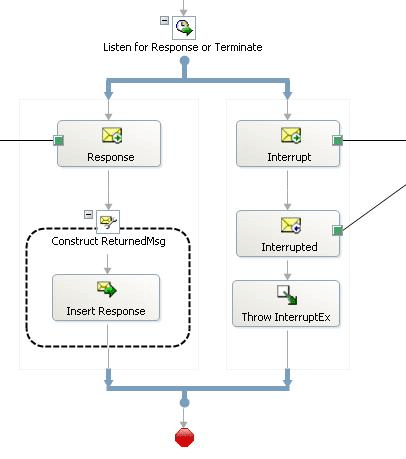
If the orchestration receives a response, it returns to the caller. If the orchestration receives an interrupt message, it passes the message on to an interrupt port and throws a custom InterruptException.
For more information about how the solution uses and handles interrupts, see Interrupt Handling in the Business Process Management Solution.
See Also
Exception Handling in the Business Process Management Solution
Custom Exceptions
Interrupt Handling in the Business Process Management Solution
The Recaller Object